Analyzing Joel's Case with Cognitive Behavioral Therapy Application
VerifiedAdded on 2023/04/10
|10
|2595
|436
Essay
AI Summary
This essay discusses the application of Cognitive Behavioral Therapy (CBT) to address the psychological challenges and depression faced by an individual named Joel. It explains the cognitive model in behavioral therapy, highlighting core beliefs, dysfunctional assumptions, and negative automatic thoughts. The essay outlines key principles of CBT, including collaboration, goal orientation, and education, and emphasizes the importance of a therapeutic relationship between the client and practitioner. It further details the process of formulation, skill acquisition, and coping strategies. Specific techniques such as guided discovery and activity scheduling are proposed to facilitate change, targeting maladaptive core beliefs and enhancing the individual's functioning by balancing parental responsibilities and professional work. The ultimate goal is to empower Joel to become his own therapist by understanding and modifying his cognitive and behavioral patterns, leading to sustainable, long-term improvement.
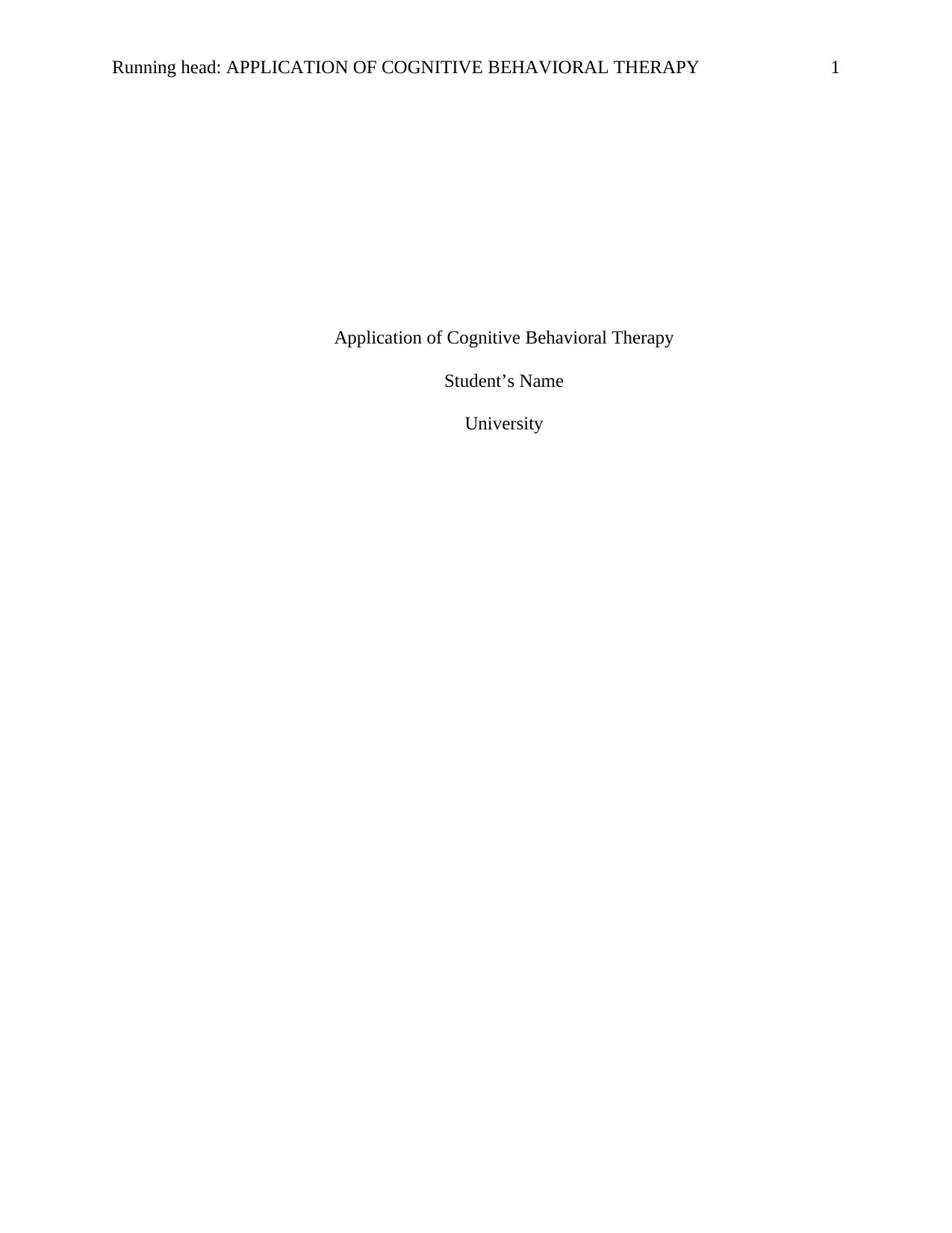
Running head: APPLICATION OF COGNITIVE BEHAVIORAL THERAPY 1
Application of Cognitive Behavioral Therapy
Student’s Name
University
Application of Cognitive Behavioral Therapy
Student’s Name
University
Paraphrase This Document
Need a fresh take? Get an instant paraphrase of this document with our AI Paraphraser
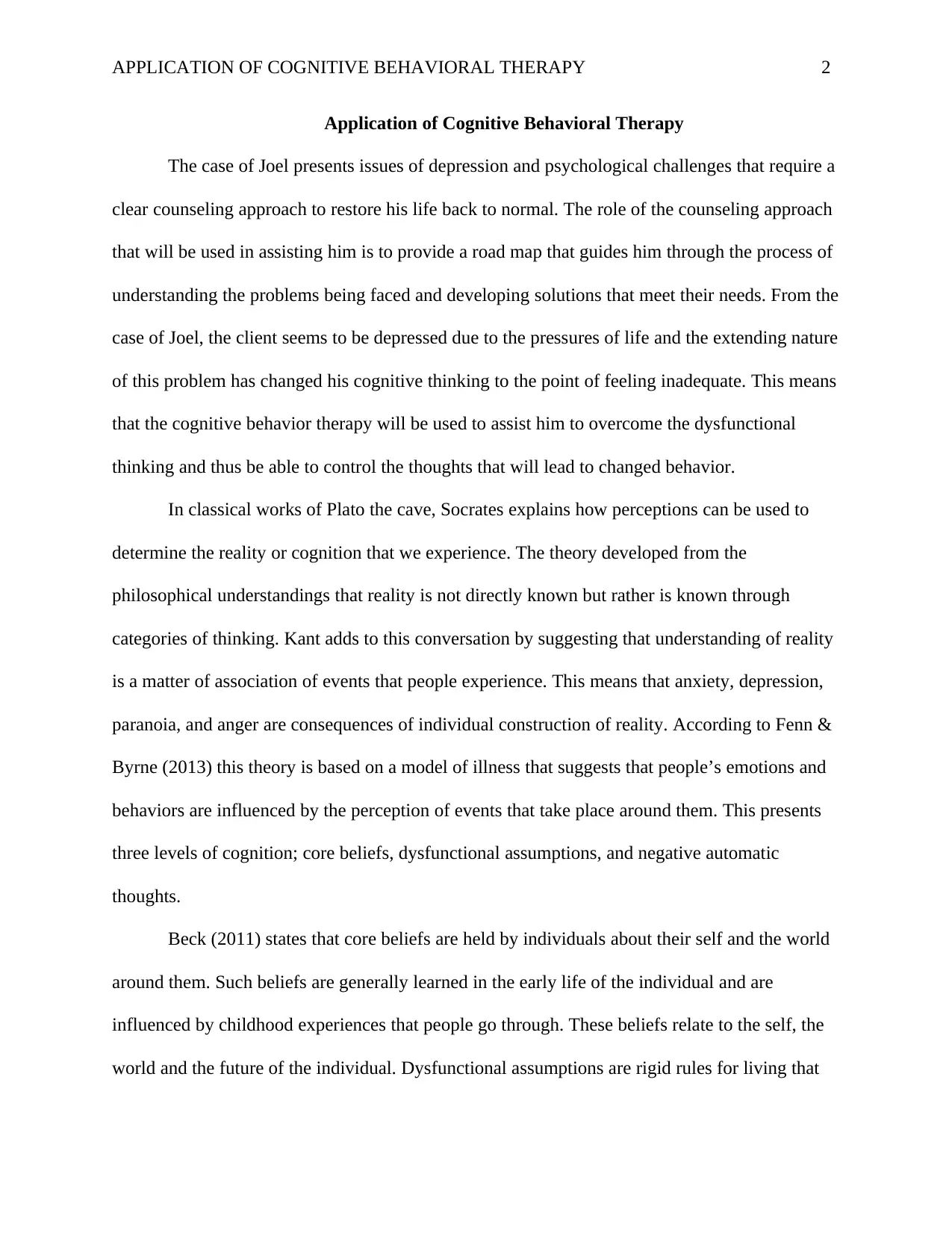
APPLICATION OF COGNITIVE BEHAVIORAL THERAPY 2
Application of Cognitive Behavioral Therapy
The case of Joel presents issues of depression and psychological challenges that require a
clear counseling approach to restore his life back to normal. The role of the counseling approach
that will be used in assisting him is to provide a road map that guides him through the process of
understanding the problems being faced and developing solutions that meet their needs. From the
case of Joel, the client seems to be depressed due to the pressures of life and the extending nature
of this problem has changed his cognitive thinking to the point of feeling inadequate. This means
that the cognitive behavior therapy will be used to assist him to overcome the dysfunctional
thinking and thus be able to control the thoughts that will lead to changed behavior.
In classical works of Plato the cave, Socrates explains how perceptions can be used to
determine the reality or cognition that we experience. The theory developed from the
philosophical understandings that reality is not directly known but rather is known through
categories of thinking. Kant adds to this conversation by suggesting that understanding of reality
is a matter of association of events that people experience. This means that anxiety, depression,
paranoia, and anger are consequences of individual construction of reality. According to Fenn &
Byrne (2013) this theory is based on a model of illness that suggests that people’s emotions and
behaviors are influenced by the perception of events that take place around them. This presents
three levels of cognition; core beliefs, dysfunctional assumptions, and negative automatic
thoughts.
Beck (2011) states that core beliefs are held by individuals about their self and the world
around them. Such beliefs are generally learned in the early life of the individual and are
influenced by childhood experiences that people go through. These beliefs relate to the self, the
world and the future of the individual. Dysfunctional assumptions are rigid rules for living that
Application of Cognitive Behavioral Therapy
The case of Joel presents issues of depression and psychological challenges that require a
clear counseling approach to restore his life back to normal. The role of the counseling approach
that will be used in assisting him is to provide a road map that guides him through the process of
understanding the problems being faced and developing solutions that meet their needs. From the
case of Joel, the client seems to be depressed due to the pressures of life and the extending nature
of this problem has changed his cognitive thinking to the point of feeling inadequate. This means
that the cognitive behavior therapy will be used to assist him to overcome the dysfunctional
thinking and thus be able to control the thoughts that will lead to changed behavior.
In classical works of Plato the cave, Socrates explains how perceptions can be used to
determine the reality or cognition that we experience. The theory developed from the
philosophical understandings that reality is not directly known but rather is known through
categories of thinking. Kant adds to this conversation by suggesting that understanding of reality
is a matter of association of events that people experience. This means that anxiety, depression,
paranoia, and anger are consequences of individual construction of reality. According to Fenn &
Byrne (2013) this theory is based on a model of illness that suggests that people’s emotions and
behaviors are influenced by the perception of events that take place around them. This presents
three levels of cognition; core beliefs, dysfunctional assumptions, and negative automatic
thoughts.
Beck (2011) states that core beliefs are held by individuals about their self and the world
around them. Such beliefs are generally learned in the early life of the individual and are
influenced by childhood experiences that people go through. These beliefs relate to the self, the
world and the future of the individual. Dysfunctional assumptions are rigid rules for living that
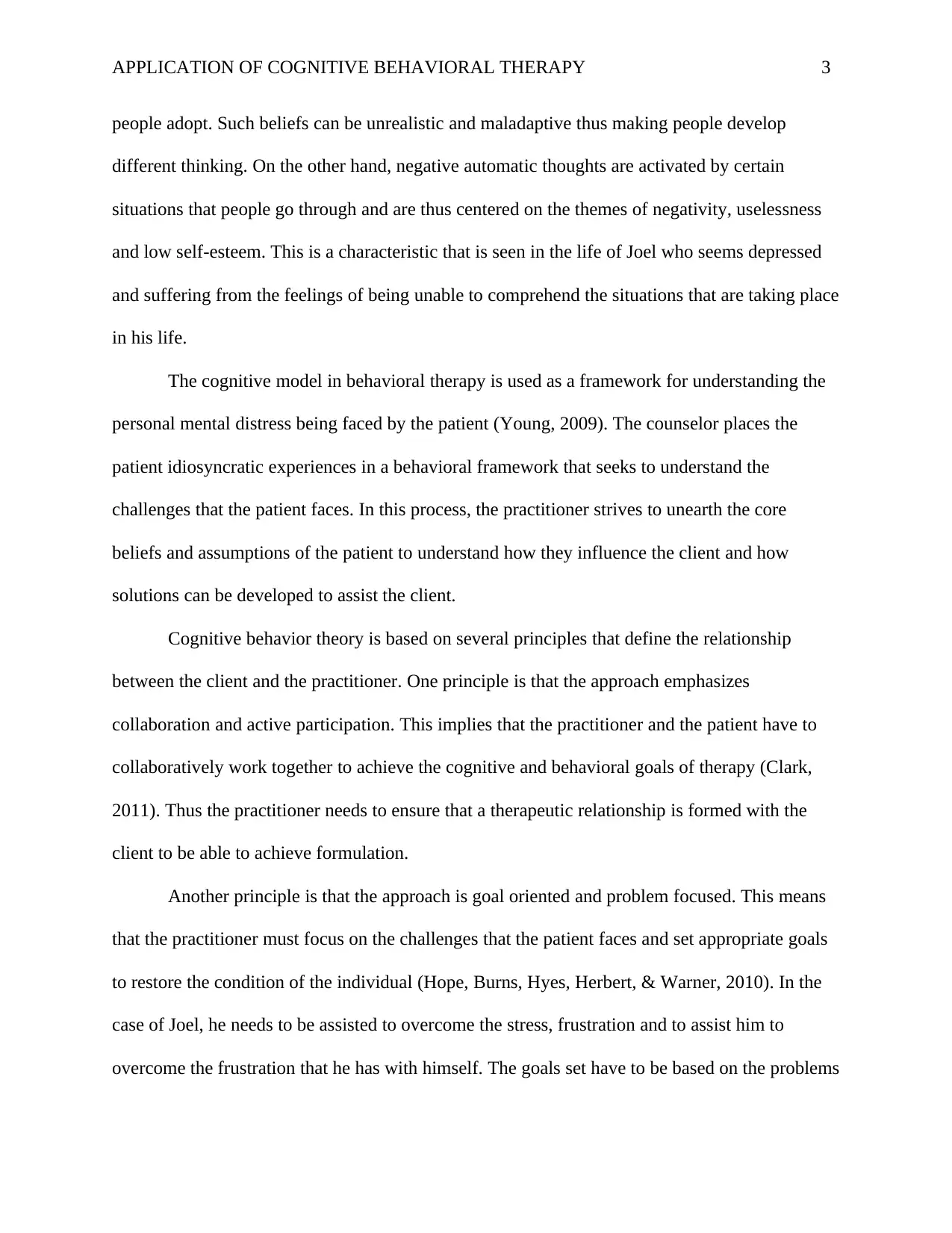
APPLICATION OF COGNITIVE BEHAVIORAL THERAPY 3
people adopt. Such beliefs can be unrealistic and maladaptive thus making people develop
different thinking. On the other hand, negative automatic thoughts are activated by certain
situations that people go through and are thus centered on the themes of negativity, uselessness
and low self-esteem. This is a characteristic that is seen in the life of Joel who seems depressed
and suffering from the feelings of being unable to comprehend the situations that are taking place
in his life.
The cognitive model in behavioral therapy is used as a framework for understanding the
personal mental distress being faced by the patient (Young, 2009). The counselor places the
patient idiosyncratic experiences in a behavioral framework that seeks to understand the
challenges that the patient faces. In this process, the practitioner strives to unearth the core
beliefs and assumptions of the patient to understand how they influence the client and how
solutions can be developed to assist the client.
Cognitive behavior theory is based on several principles that define the relationship
between the client and the practitioner. One principle is that the approach emphasizes
collaboration and active participation. This implies that the practitioner and the patient have to
collaboratively work together to achieve the cognitive and behavioral goals of therapy (Clark,
2011). Thus the practitioner needs to ensure that a therapeutic relationship is formed with the
client to be able to achieve formulation.
Another principle is that the approach is goal oriented and problem focused. This means
that the practitioner must focus on the challenges that the patient faces and set appropriate goals
to restore the condition of the individual (Hope, Burns, Hyes, Herbert, & Warner, 2010). In the
case of Joel, he needs to be assisted to overcome the stress, frustration and to assist him to
overcome the frustration that he has with himself. The goals set have to be based on the problems
people adopt. Such beliefs can be unrealistic and maladaptive thus making people develop
different thinking. On the other hand, negative automatic thoughts are activated by certain
situations that people go through and are thus centered on the themes of negativity, uselessness
and low self-esteem. This is a characteristic that is seen in the life of Joel who seems depressed
and suffering from the feelings of being unable to comprehend the situations that are taking place
in his life.
The cognitive model in behavioral therapy is used as a framework for understanding the
personal mental distress being faced by the patient (Young, 2009). The counselor places the
patient idiosyncratic experiences in a behavioral framework that seeks to understand the
challenges that the patient faces. In this process, the practitioner strives to unearth the core
beliefs and assumptions of the patient to understand how they influence the client and how
solutions can be developed to assist the client.
Cognitive behavior theory is based on several principles that define the relationship
between the client and the practitioner. One principle is that the approach emphasizes
collaboration and active participation. This implies that the practitioner and the patient have to
collaboratively work together to achieve the cognitive and behavioral goals of therapy (Clark,
2011). Thus the practitioner needs to ensure that a therapeutic relationship is formed with the
client to be able to achieve formulation.
Another principle is that the approach is goal oriented and problem focused. This means
that the practitioner must focus on the challenges that the patient faces and set appropriate goals
to restore the condition of the individual (Hope, Burns, Hyes, Herbert, & Warner, 2010). In the
case of Joel, he needs to be assisted to overcome the stress, frustration and to assist him to
overcome the frustration that he has with himself. The goals set have to be based on the problems
⊘ This is a preview!⊘
Do you want full access?
Subscribe today to unlock all pages.

Trusted by 1+ million students worldwide
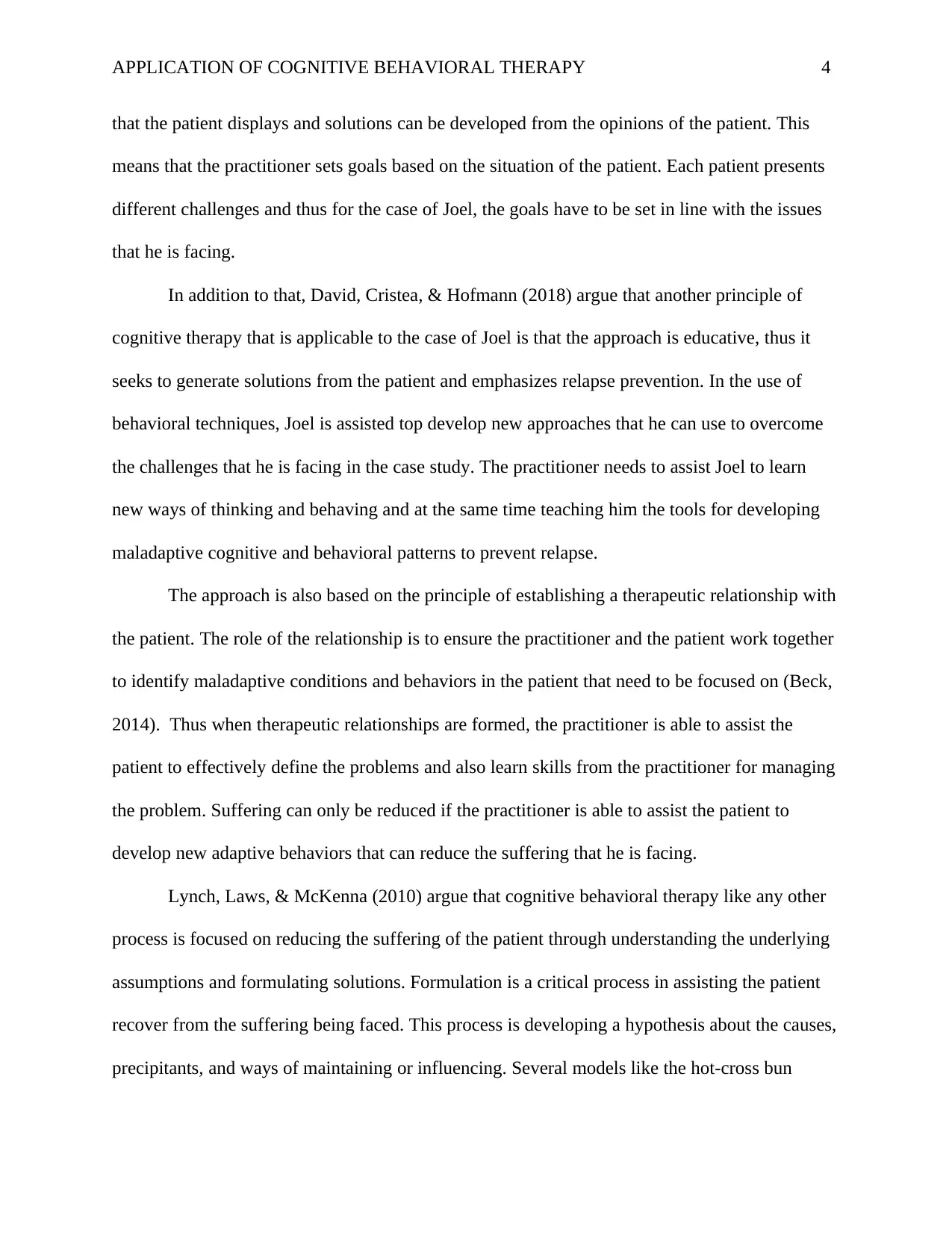
APPLICATION OF COGNITIVE BEHAVIORAL THERAPY 4
that the patient displays and solutions can be developed from the opinions of the patient. This
means that the practitioner sets goals based on the situation of the patient. Each patient presents
different challenges and thus for the case of Joel, the goals have to be set in line with the issues
that he is facing.
In addition to that, David, Cristea, & Hofmann (2018) argue that another principle of
cognitive therapy that is applicable to the case of Joel is that the approach is educative, thus it
seeks to generate solutions from the patient and emphasizes relapse prevention. In the use of
behavioral techniques, Joel is assisted top develop new approaches that he can use to overcome
the challenges that he is facing in the case study. The practitioner needs to assist Joel to learn
new ways of thinking and behaving and at the same time teaching him the tools for developing
maladaptive cognitive and behavioral patterns to prevent relapse.
The approach is also based on the principle of establishing a therapeutic relationship with
the patient. The role of the relationship is to ensure the practitioner and the patient work together
to identify maladaptive conditions and behaviors in the patient that need to be focused on (Beck,
2014). Thus when therapeutic relationships are formed, the practitioner is able to assist the
patient to effectively define the problems and also learn skills from the practitioner for managing
the problem. Suffering can only be reduced if the practitioner is able to assist the patient to
develop new adaptive behaviors that can reduce the suffering that he is facing.
Lynch, Laws, & McKenna (2010) argue that cognitive behavioral therapy like any other
process is focused on reducing the suffering of the patient through understanding the underlying
assumptions and formulating solutions. Formulation is a critical process in assisting the patient
recover from the suffering being faced. This process is developing a hypothesis about the causes,
precipitants, and ways of maintaining or influencing. Several models like the hot-cross bun
that the patient displays and solutions can be developed from the opinions of the patient. This
means that the practitioner sets goals based on the situation of the patient. Each patient presents
different challenges and thus for the case of Joel, the goals have to be set in line with the issues
that he is facing.
In addition to that, David, Cristea, & Hofmann (2018) argue that another principle of
cognitive therapy that is applicable to the case of Joel is that the approach is educative, thus it
seeks to generate solutions from the patient and emphasizes relapse prevention. In the use of
behavioral techniques, Joel is assisted top develop new approaches that he can use to overcome
the challenges that he is facing in the case study. The practitioner needs to assist Joel to learn
new ways of thinking and behaving and at the same time teaching him the tools for developing
maladaptive cognitive and behavioral patterns to prevent relapse.
The approach is also based on the principle of establishing a therapeutic relationship with
the patient. The role of the relationship is to ensure the practitioner and the patient work together
to identify maladaptive conditions and behaviors in the patient that need to be focused on (Beck,
2014). Thus when therapeutic relationships are formed, the practitioner is able to assist the
patient to effectively define the problems and also learn skills from the practitioner for managing
the problem. Suffering can only be reduced if the practitioner is able to assist the patient to
develop new adaptive behaviors that can reduce the suffering that he is facing.
Lynch, Laws, & McKenna (2010) argue that cognitive behavioral therapy like any other
process is focused on reducing the suffering of the patient through understanding the underlying
assumptions and formulating solutions. Formulation is a critical process in assisting the patient
recover from the suffering being faced. This process is developing a hypothesis about the causes,
precipitants, and ways of maintaining or influencing. Several models like the hot-cross bun
Paraphrase This Document
Need a fresh take? Get an instant paraphrase of this document with our AI Paraphraser
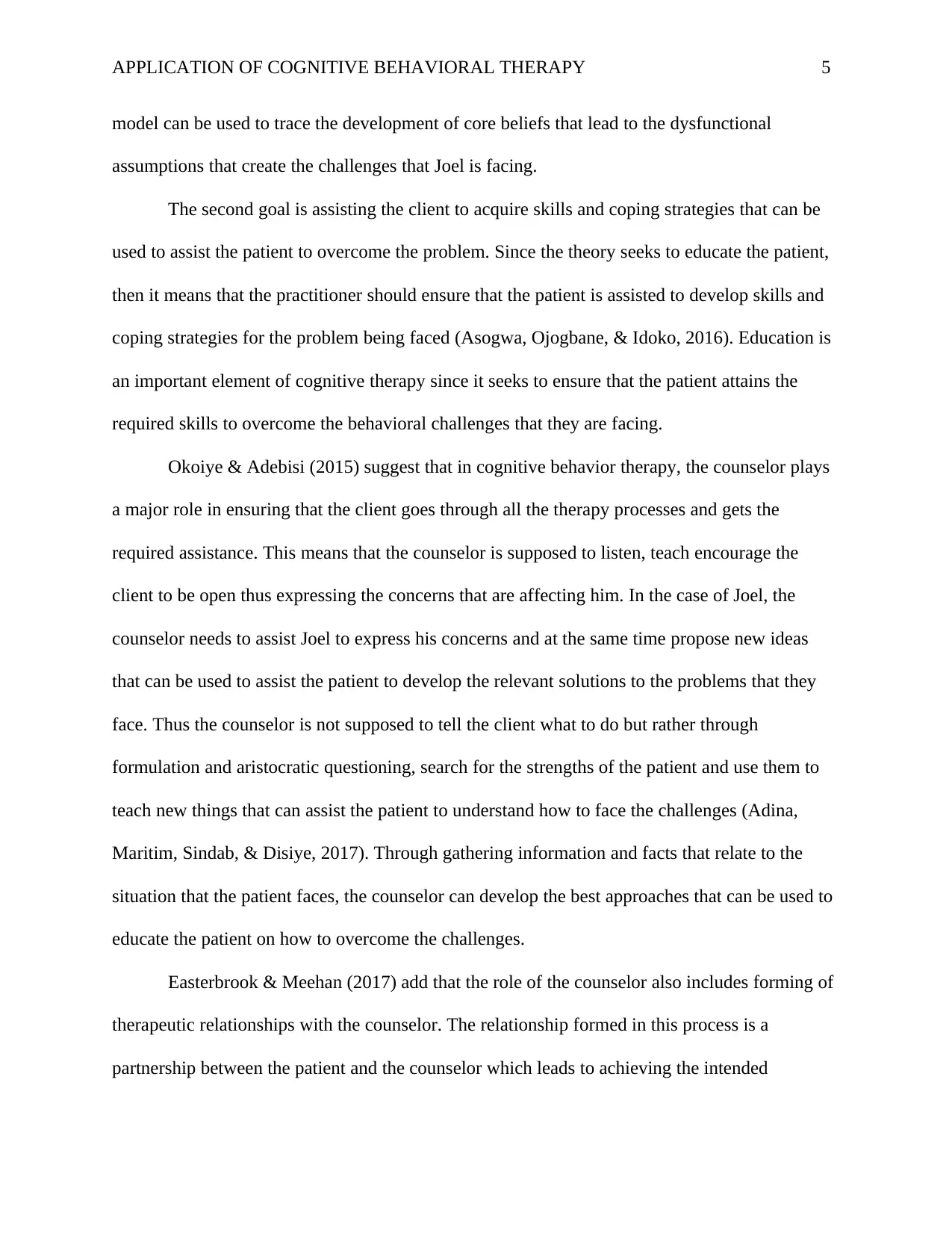
APPLICATION OF COGNITIVE BEHAVIORAL THERAPY 5
model can be used to trace the development of core beliefs that lead to the dysfunctional
assumptions that create the challenges that Joel is facing.
The second goal is assisting the client to acquire skills and coping strategies that can be
used to assist the patient to overcome the problem. Since the theory seeks to educate the patient,
then it means that the practitioner should ensure that the patient is assisted to develop skills and
coping strategies for the problem being faced (Asogwa, Ojogbane, & Idoko, 2016). Education is
an important element of cognitive therapy since it seeks to ensure that the patient attains the
required skills to overcome the behavioral challenges that they are facing.
Okoiye & Adebisi (2015) suggest that in cognitive behavior therapy, the counselor plays
a major role in ensuring that the client goes through all the therapy processes and gets the
required assistance. This means that the counselor is supposed to listen, teach encourage the
client to be open thus expressing the concerns that are affecting him. In the case of Joel, the
counselor needs to assist Joel to express his concerns and at the same time propose new ideas
that can be used to assist the patient to develop the relevant solutions to the problems that they
face. Thus the counselor is not supposed to tell the client what to do but rather through
formulation and aristocratic questioning, search for the strengths of the patient and use them to
teach new things that can assist the patient to understand how to face the challenges (Adina,
Maritim, Sindab, & Disiye, 2017). Through gathering information and facts that relate to the
situation that the patient faces, the counselor can develop the best approaches that can be used to
educate the patient on how to overcome the challenges.
Easterbrook & Meehan (2017) add that the role of the counselor also includes forming of
therapeutic relationships with the counselor. The relationship formed in this process is a
partnership between the patient and the counselor which leads to achieving the intended
model can be used to trace the development of core beliefs that lead to the dysfunctional
assumptions that create the challenges that Joel is facing.
The second goal is assisting the client to acquire skills and coping strategies that can be
used to assist the patient to overcome the problem. Since the theory seeks to educate the patient,
then it means that the practitioner should ensure that the patient is assisted to develop skills and
coping strategies for the problem being faced (Asogwa, Ojogbane, & Idoko, 2016). Education is
an important element of cognitive therapy since it seeks to ensure that the patient attains the
required skills to overcome the behavioral challenges that they are facing.
Okoiye & Adebisi (2015) suggest that in cognitive behavior therapy, the counselor plays
a major role in ensuring that the client goes through all the therapy processes and gets the
required assistance. This means that the counselor is supposed to listen, teach encourage the
client to be open thus expressing the concerns that are affecting him. In the case of Joel, the
counselor needs to assist Joel to express his concerns and at the same time propose new ideas
that can be used to assist the patient to develop the relevant solutions to the problems that they
face. Thus the counselor is not supposed to tell the client what to do but rather through
formulation and aristocratic questioning, search for the strengths of the patient and use them to
teach new things that can assist the patient to understand how to face the challenges (Adina,
Maritim, Sindab, & Disiye, 2017). Through gathering information and facts that relate to the
situation that the patient faces, the counselor can develop the best approaches that can be used to
educate the patient on how to overcome the challenges.
Easterbrook & Meehan (2017) add that the role of the counselor also includes forming of
therapeutic relationships with the counselor. The relationship formed in this process is a
partnership between the patient and the counselor which leads to achieving the intended
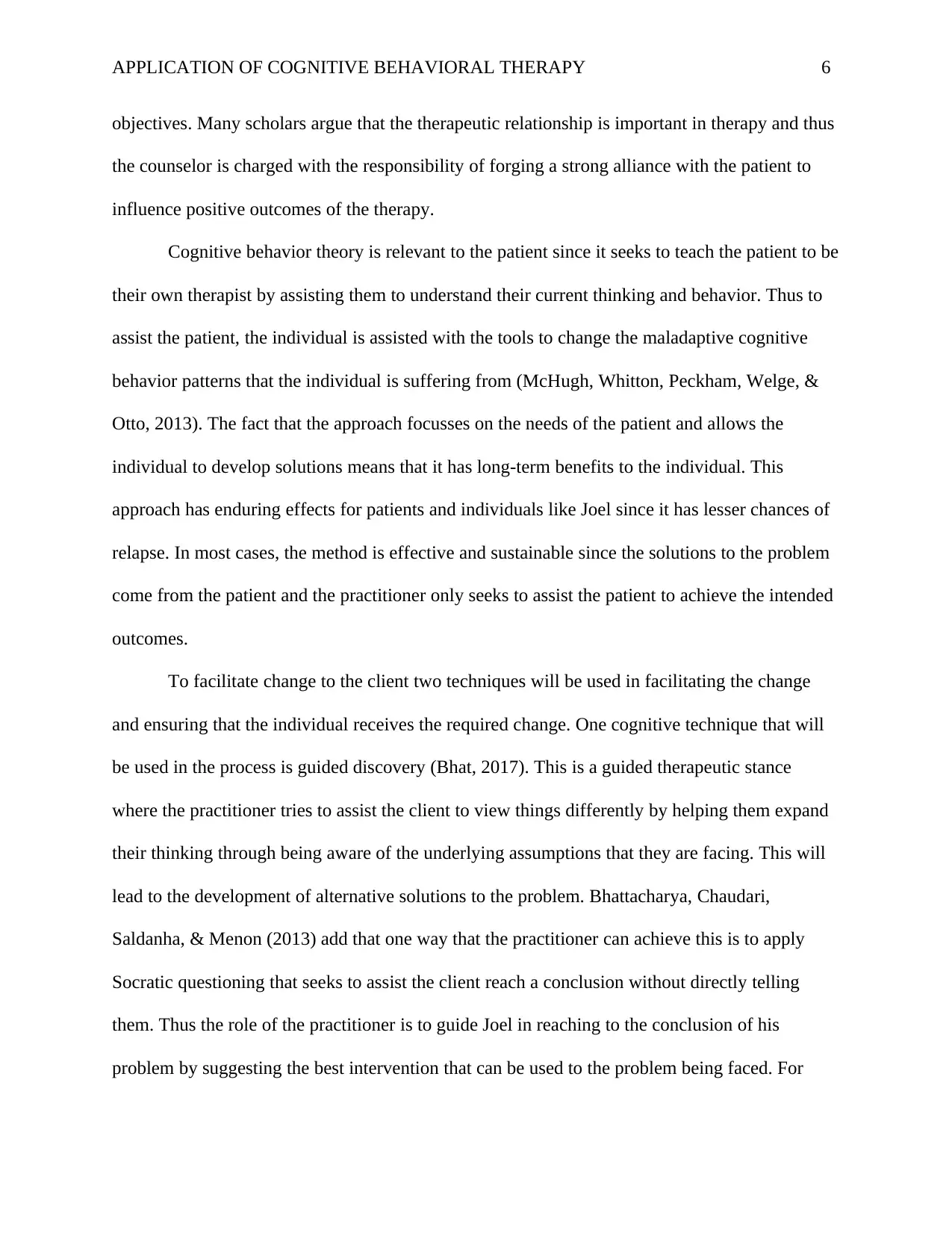
APPLICATION OF COGNITIVE BEHAVIORAL THERAPY 6
objectives. Many scholars argue that the therapeutic relationship is important in therapy and thus
the counselor is charged with the responsibility of forging a strong alliance with the patient to
influence positive outcomes of the therapy.
Cognitive behavior theory is relevant to the patient since it seeks to teach the patient to be
their own therapist by assisting them to understand their current thinking and behavior. Thus to
assist the patient, the individual is assisted with the tools to change the maladaptive cognitive
behavior patterns that the individual is suffering from (McHugh, Whitton, Peckham, Welge, &
Otto, 2013). The fact that the approach focusses on the needs of the patient and allows the
individual to develop solutions means that it has long-term benefits to the individual. This
approach has enduring effects for patients and individuals like Joel since it has lesser chances of
relapse. In most cases, the method is effective and sustainable since the solutions to the problem
come from the patient and the practitioner only seeks to assist the patient to achieve the intended
outcomes.
To facilitate change to the client two techniques will be used in facilitating the change
and ensuring that the individual receives the required change. One cognitive technique that will
be used in the process is guided discovery (Bhat, 2017). This is a guided therapeutic stance
where the practitioner tries to assist the client to view things differently by helping them expand
their thinking through being aware of the underlying assumptions that they are facing. This will
lead to the development of alternative solutions to the problem. Bhattacharya, Chaudari,
Saldanha, & Menon (2013) add that one way that the practitioner can achieve this is to apply
Socratic questioning that seeks to assist the client reach a conclusion without directly telling
them. Thus the role of the practitioner is to guide Joel in reaching to the conclusion of his
problem by suggesting the best intervention that can be used to the problem being faced. For
objectives. Many scholars argue that the therapeutic relationship is important in therapy and thus
the counselor is charged with the responsibility of forging a strong alliance with the patient to
influence positive outcomes of the therapy.
Cognitive behavior theory is relevant to the patient since it seeks to teach the patient to be
their own therapist by assisting them to understand their current thinking and behavior. Thus to
assist the patient, the individual is assisted with the tools to change the maladaptive cognitive
behavior patterns that the individual is suffering from (McHugh, Whitton, Peckham, Welge, &
Otto, 2013). The fact that the approach focusses on the needs of the patient and allows the
individual to develop solutions means that it has long-term benefits to the individual. This
approach has enduring effects for patients and individuals like Joel since it has lesser chances of
relapse. In most cases, the method is effective and sustainable since the solutions to the problem
come from the patient and the practitioner only seeks to assist the patient to achieve the intended
outcomes.
To facilitate change to the client two techniques will be used in facilitating the change
and ensuring that the individual receives the required change. One cognitive technique that will
be used in the process is guided discovery (Bhat, 2017). This is a guided therapeutic stance
where the practitioner tries to assist the client to view things differently by helping them expand
their thinking through being aware of the underlying assumptions that they are facing. This will
lead to the development of alternative solutions to the problem. Bhattacharya, Chaudari,
Saldanha, & Menon (2013) add that one way that the practitioner can achieve this is to apply
Socratic questioning that seeks to assist the client reach a conclusion without directly telling
them. Thus the role of the practitioner is to guide Joel in reaching to the conclusion of his
problem by suggesting the best intervention that can be used to the problem being faced. For
⊘ This is a preview!⊘
Do you want full access?
Subscribe today to unlock all pages.

Trusted by 1+ million students worldwide
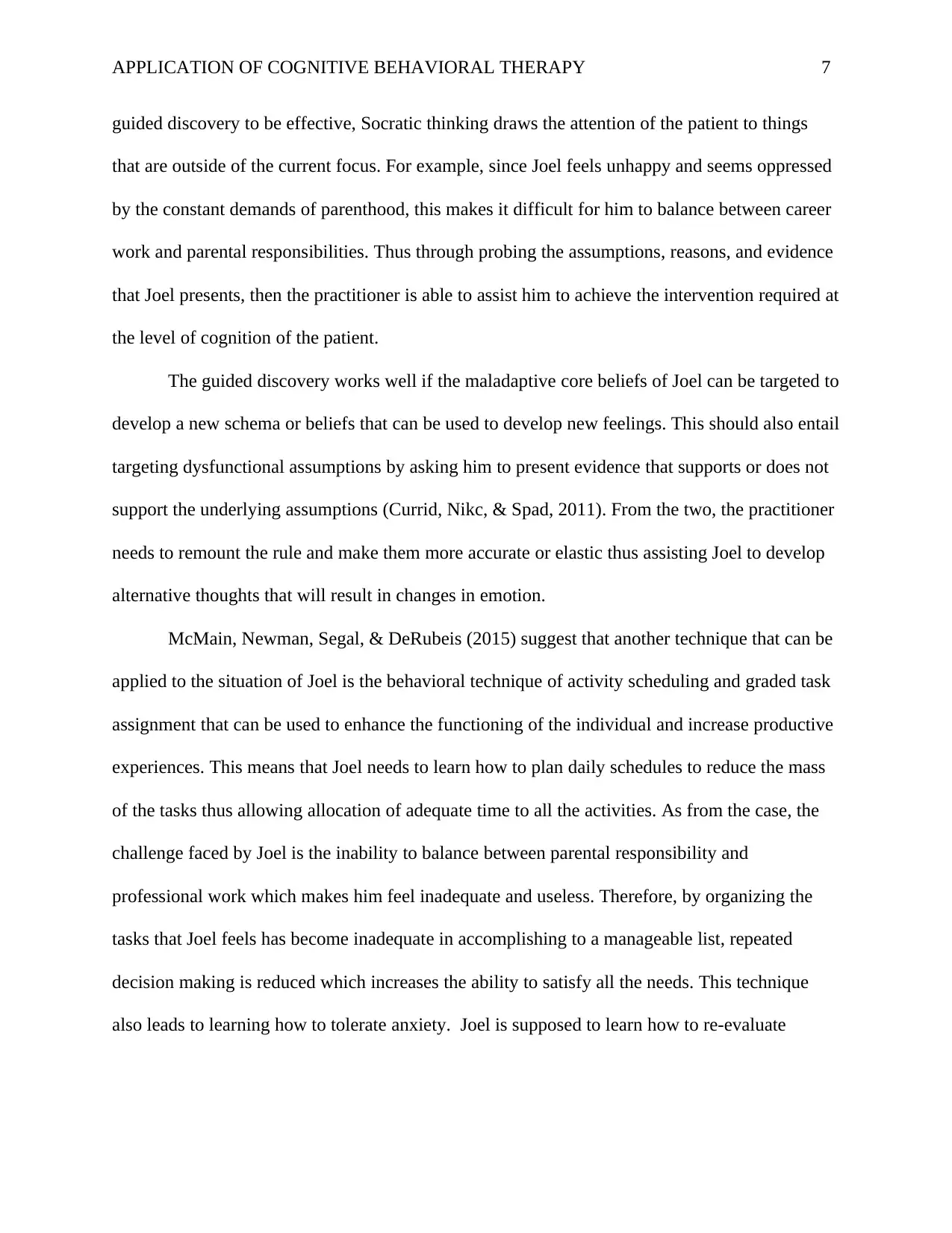
APPLICATION OF COGNITIVE BEHAVIORAL THERAPY 7
guided discovery to be effective, Socratic thinking draws the attention of the patient to things
that are outside of the current focus. For example, since Joel feels unhappy and seems oppressed
by the constant demands of parenthood, this makes it difficult for him to balance between career
work and parental responsibilities. Thus through probing the assumptions, reasons, and evidence
that Joel presents, then the practitioner is able to assist him to achieve the intervention required at
the level of cognition of the patient.
The guided discovery works well if the maladaptive core beliefs of Joel can be targeted to
develop a new schema or beliefs that can be used to develop new feelings. This should also entail
targeting dysfunctional assumptions by asking him to present evidence that supports or does not
support the underlying assumptions (Currid, Nikc, & Spad, 2011). From the two, the practitioner
needs to remount the rule and make them more accurate or elastic thus assisting Joel to develop
alternative thoughts that will result in changes in emotion.
McMain, Newman, Segal, & DeRubeis (2015) suggest that another technique that can be
applied to the situation of Joel is the behavioral technique of activity scheduling and graded task
assignment that can be used to enhance the functioning of the individual and increase productive
experiences. This means that Joel needs to learn how to plan daily schedules to reduce the mass
of the tasks thus allowing allocation of adequate time to all the activities. As from the case, the
challenge faced by Joel is the inability to balance between parental responsibility and
professional work which makes him feel inadequate and useless. Therefore, by organizing the
tasks that Joel feels has become inadequate in accomplishing to a manageable list, repeated
decision making is reduced which increases the ability to satisfy all the needs. This technique
also leads to learning how to tolerate anxiety. Joel is supposed to learn how to re-evaluate
guided discovery to be effective, Socratic thinking draws the attention of the patient to things
that are outside of the current focus. For example, since Joel feels unhappy and seems oppressed
by the constant demands of parenthood, this makes it difficult for him to balance between career
work and parental responsibilities. Thus through probing the assumptions, reasons, and evidence
that Joel presents, then the practitioner is able to assist him to achieve the intervention required at
the level of cognition of the patient.
The guided discovery works well if the maladaptive core beliefs of Joel can be targeted to
develop a new schema or beliefs that can be used to develop new feelings. This should also entail
targeting dysfunctional assumptions by asking him to present evidence that supports or does not
support the underlying assumptions (Currid, Nikc, & Spad, 2011). From the two, the practitioner
needs to remount the rule and make them more accurate or elastic thus assisting Joel to develop
alternative thoughts that will result in changes in emotion.
McMain, Newman, Segal, & DeRubeis (2015) suggest that another technique that can be
applied to the situation of Joel is the behavioral technique of activity scheduling and graded task
assignment that can be used to enhance the functioning of the individual and increase productive
experiences. This means that Joel needs to learn how to plan daily schedules to reduce the mass
of the tasks thus allowing allocation of adequate time to all the activities. As from the case, the
challenge faced by Joel is the inability to balance between parental responsibility and
professional work which makes him feel inadequate and useless. Therefore, by organizing the
tasks that Joel feels has become inadequate in accomplishing to a manageable list, repeated
decision making is reduced which increases the ability to satisfy all the needs. This technique
also leads to learning how to tolerate anxiety. Joel is supposed to learn how to re-evaluate
Paraphrase This Document
Need a fresh take? Get an instant paraphrase of this document with our AI Paraphraser
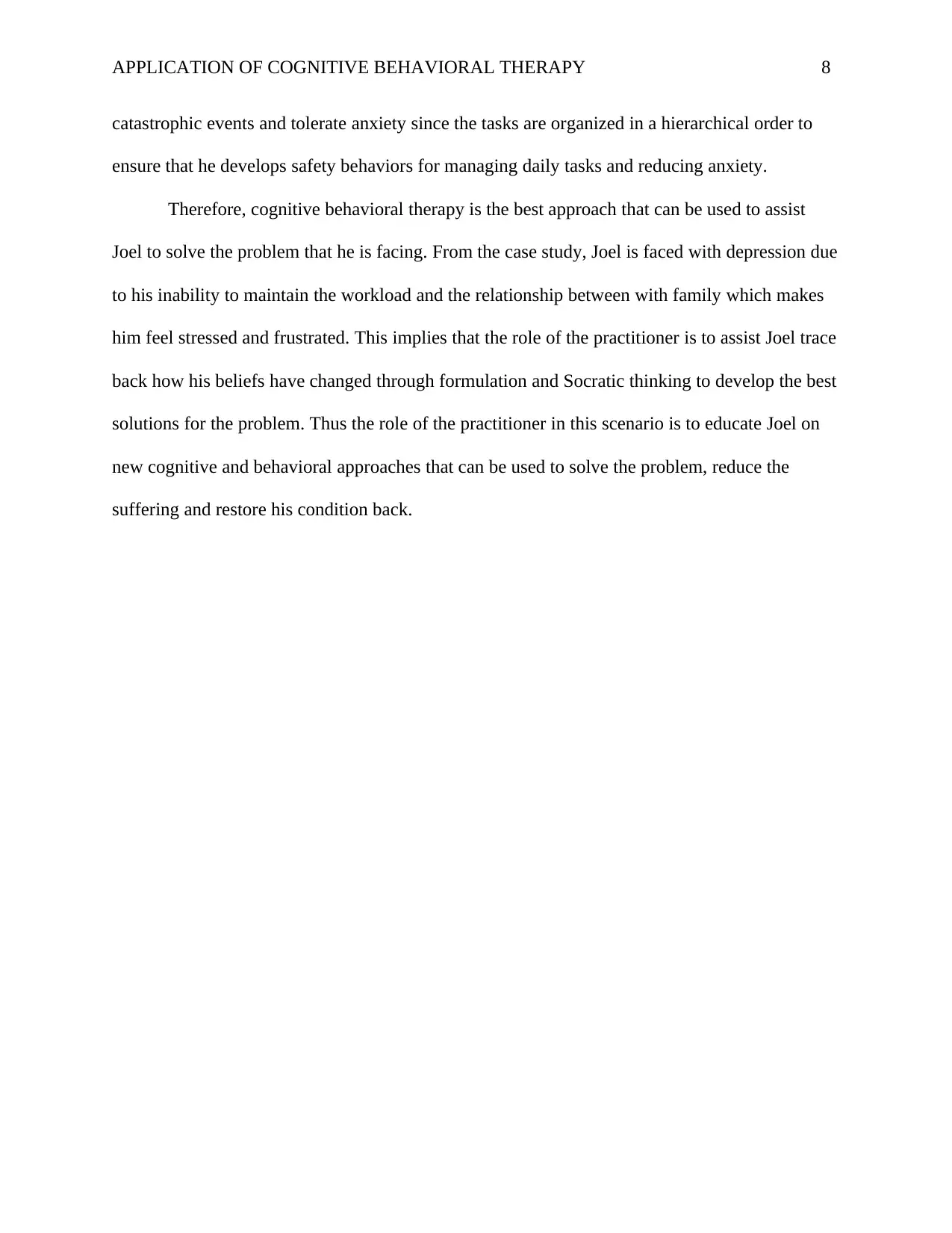
APPLICATION OF COGNITIVE BEHAVIORAL THERAPY 8
catastrophic events and tolerate anxiety since the tasks are organized in a hierarchical order to
ensure that he develops safety behaviors for managing daily tasks and reducing anxiety.
Therefore, cognitive behavioral therapy is the best approach that can be used to assist
Joel to solve the problem that he is facing. From the case study, Joel is faced with depression due
to his inability to maintain the workload and the relationship between with family which makes
him feel stressed and frustrated. This implies that the role of the practitioner is to assist Joel trace
back how his beliefs have changed through formulation and Socratic thinking to develop the best
solutions for the problem. Thus the role of the practitioner in this scenario is to educate Joel on
new cognitive and behavioral approaches that can be used to solve the problem, reduce the
suffering and restore his condition back.
catastrophic events and tolerate anxiety since the tasks are organized in a hierarchical order to
ensure that he develops safety behaviors for managing daily tasks and reducing anxiety.
Therefore, cognitive behavioral therapy is the best approach that can be used to assist
Joel to solve the problem that he is facing. From the case study, Joel is faced with depression due
to his inability to maintain the workload and the relationship between with family which makes
him feel stressed and frustrated. This implies that the role of the practitioner is to assist Joel trace
back how his beliefs have changed through formulation and Socratic thinking to develop the best
solutions for the problem. Thus the role of the practitioner in this scenario is to educate Joel on
new cognitive and behavioral approaches that can be used to solve the problem, reduce the
suffering and restore his condition back.
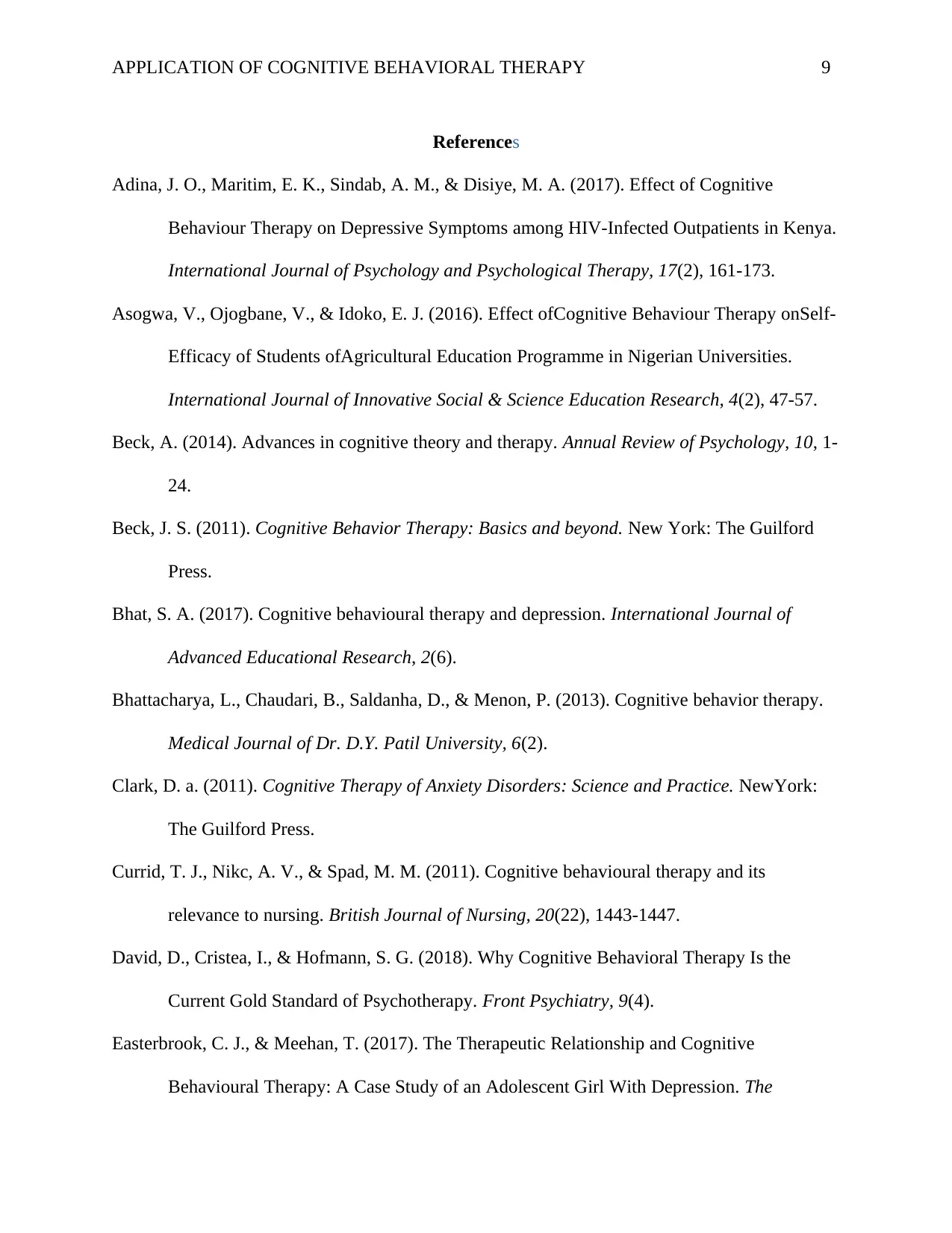
APPLICATION OF COGNITIVE BEHAVIORAL THERAPY 9
References
Adina, J. O., Maritim, E. K., Sindab, A. M., & Disiye, M. A. (2017). Effect of Cognitive
Behaviour Therapy on Depressive Symptoms among HIV-Infected Outpatients in Kenya.
International Journal of Psychology and Psychological Therapy, 17(2), 161-173.
Asogwa, V., Ojogbane, V., & Idoko, E. J. (2016). Effect ofCognitive Behaviour Therapy onSelf-
Efficacy of Students ofAgricultural Education Programme in Nigerian Universities.
International Journal of Innovative Social & Science Education Research, 4(2), 47-57.
Beck, A. (2014). Advances in cognitive theory and therapy. Annual Review of Psychology, 10, 1-
24.
Beck, J. S. (2011). Cognitive Behavior Therapy: Basics and beyond. New York: The Guilford
Press.
Bhat, S. A. (2017). Cognitive behavioural therapy and depression. International Journal of
Advanced Educational Research, 2(6).
Bhattacharya, L., Chaudari, B., Saldanha, D., & Menon, P. (2013). Cognitive behavior therapy.
Medical Journal of Dr. D.Y. Patil University, 6(2).
Clark, D. a. (2011). Cognitive Therapy of Anxiety Disorders: Science and Practice. NewYork:
The Guilford Press.
Currid, T. J., Nikc, A. V., & Spad, M. M. (2011). Cognitive behavioural therapy and its
relevance to nursing. British Journal of Nursing, 20(22), 1443-1447.
David, D., Cristea, I., & Hofmann, S. G. (2018). Why Cognitive Behavioral Therapy Is the
Current Gold Standard of Psychotherapy. Front Psychiatry, 9(4).
Easterbrook, C. J., & Meehan, T. (2017). The Therapeutic Relationship and Cognitive
Behavioural Therapy: A Case Study of an Adolescent Girl With Depression. The
References
Adina, J. O., Maritim, E. K., Sindab, A. M., & Disiye, M. A. (2017). Effect of Cognitive
Behaviour Therapy on Depressive Symptoms among HIV-Infected Outpatients in Kenya.
International Journal of Psychology and Psychological Therapy, 17(2), 161-173.
Asogwa, V., Ojogbane, V., & Idoko, E. J. (2016). Effect ofCognitive Behaviour Therapy onSelf-
Efficacy of Students ofAgricultural Education Programme in Nigerian Universities.
International Journal of Innovative Social & Science Education Research, 4(2), 47-57.
Beck, A. (2014). Advances in cognitive theory and therapy. Annual Review of Psychology, 10, 1-
24.
Beck, J. S. (2011). Cognitive Behavior Therapy: Basics and beyond. New York: The Guilford
Press.
Bhat, S. A. (2017). Cognitive behavioural therapy and depression. International Journal of
Advanced Educational Research, 2(6).
Bhattacharya, L., Chaudari, B., Saldanha, D., & Menon, P. (2013). Cognitive behavior therapy.
Medical Journal of Dr. D.Y. Patil University, 6(2).
Clark, D. a. (2011). Cognitive Therapy of Anxiety Disorders: Science and Practice. NewYork:
The Guilford Press.
Currid, T. J., Nikc, A. V., & Spad, M. M. (2011). Cognitive behavioural therapy and its
relevance to nursing. British Journal of Nursing, 20(22), 1443-1447.
David, D., Cristea, I., & Hofmann, S. G. (2018). Why Cognitive Behavioral Therapy Is the
Current Gold Standard of Psychotherapy. Front Psychiatry, 9(4).
Easterbrook, C. J., & Meehan, T. (2017). The Therapeutic Relationship and Cognitive
Behavioural Therapy: A Case Study of an Adolescent Girl With Depression. The
⊘ This is a preview!⊘
Do you want full access?
Subscribe today to unlock all pages.

Trusted by 1+ million students worldwide
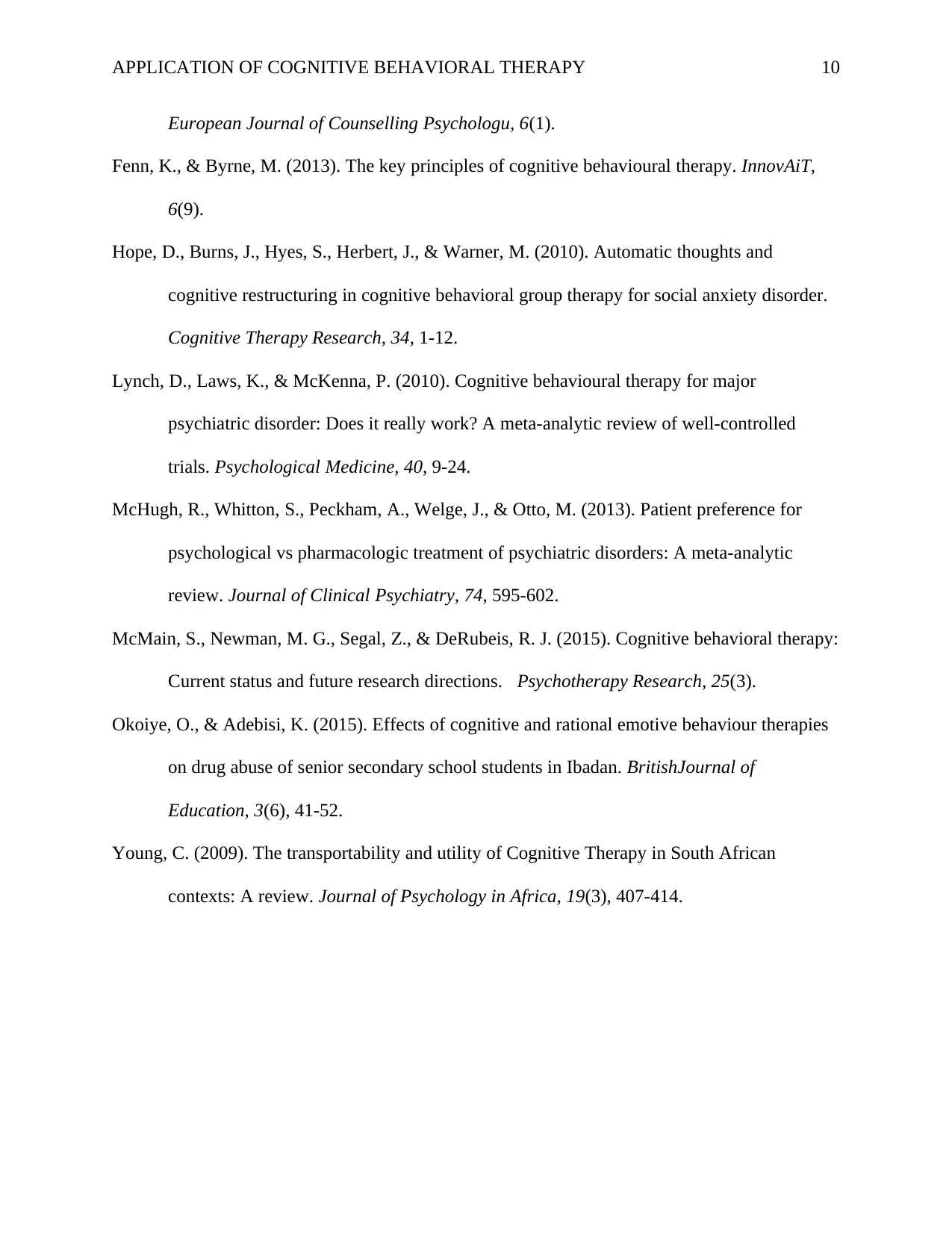
APPLICATION OF COGNITIVE BEHAVIORAL THERAPY 10
European Journal of Counselling Psychologu, 6(1).
Fenn, K., & Byrne, M. (2013). The key principles of cognitive behavioural therapy. InnovAiT,
6(9).
Hope, D., Burns, J., Hyes, S., Herbert, J., & Warner, M. (2010). Automatic thoughts and
cognitive restructuring in cognitive behavioral group therapy for social anxiety disorder.
Cognitive Therapy Research, 34, 1-12.
Lynch, D., Laws, K., & McKenna, P. (2010). Cognitive behavioural therapy for major
psychiatric disorder: Does it really work? A meta-analytic review of well-controlled
trials. Psychological Medicine, 40, 9-24.
McHugh, R., Whitton, S., Peckham, A., Welge, J., & Otto, M. (2013). Patient preference for
psychological vs pharmacologic treatment of psychiatric disorders: A meta-analytic
review. Journal of Clinical Psychiatry, 74, 595-602.
McMain, S., Newman, M. G., Segal, Z., & DeRubeis, R. J. (2015). Cognitive behavioral therapy:
Current status and future research directions. Psychotherapy Research, 25(3).
Okoiye, O., & Adebisi, K. (2015). Effects of cognitive and rational emotive behaviour therapies
on drug abuse of senior secondary school students in Ibadan. BritishJournal of
Education, 3(6), 41-52.
Young, C. (2009). The transportability and utility of Cognitive Therapy in South African
contexts: A review. Journal of Psychology in Africa, 19(3), 407-414.
European Journal of Counselling Psychologu, 6(1).
Fenn, K., & Byrne, M. (2013). The key principles of cognitive behavioural therapy. InnovAiT,
6(9).
Hope, D., Burns, J., Hyes, S., Herbert, J., & Warner, M. (2010). Automatic thoughts and
cognitive restructuring in cognitive behavioral group therapy for social anxiety disorder.
Cognitive Therapy Research, 34, 1-12.
Lynch, D., Laws, K., & McKenna, P. (2010). Cognitive behavioural therapy for major
psychiatric disorder: Does it really work? A meta-analytic review of well-controlled
trials. Psychological Medicine, 40, 9-24.
McHugh, R., Whitton, S., Peckham, A., Welge, J., & Otto, M. (2013). Patient preference for
psychological vs pharmacologic treatment of psychiatric disorders: A meta-analytic
review. Journal of Clinical Psychiatry, 74, 595-602.
McMain, S., Newman, M. G., Segal, Z., & DeRubeis, R. J. (2015). Cognitive behavioral therapy:
Current status and future research directions. Psychotherapy Research, 25(3).
Okoiye, O., & Adebisi, K. (2015). Effects of cognitive and rational emotive behaviour therapies
on drug abuse of senior secondary school students in Ibadan. BritishJournal of
Education, 3(6), 41-52.
Young, C. (2009). The transportability and utility of Cognitive Therapy in South African
contexts: A review. Journal of Psychology in Africa, 19(3), 407-414.
1 out of 10
Related Documents
Your All-in-One AI-Powered Toolkit for Academic Success.
+13062052269
info@desklib.com
Available 24*7 on WhatsApp / Email
![[object Object]](/_next/static/media/star-bottom.7253800d.svg)
Unlock your academic potential
Copyright © 2020–2025 A2Z Services. All Rights Reserved. Developed and managed by ZUCOL.





